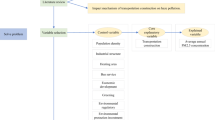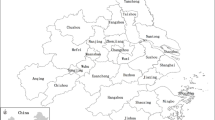Abstract
To improve the air pollution of China fundamentally, effective measures should be proposed based on the thorough understanding of the characteristics of air pollution. Based on spatial econometrics, this paper investigates the characteristics and analyzes the determinants of the spatial concentration of PM2.5 pollution in China. Results show that: (1) PM2.5 pollution is highly concentrated in Central and Eastern China, covering 17 regions which accounts for 75% of the total population and GDP (gross domestic product). (2) The PM2.5 values in China show a significant spatial correlation. Provinces such as Shandong, Henan, Anhui, and Hubei are high in PM2.5 concentration. Meanwhile, these provinces are high in population density, GDP, and coal consumptions and have a large amount of civilian cars. (3) PM2.5 pollution shows spatial spillover effects. A 1% increase in the PM2.5 values of neighboring provinces will lead to a 0.78% increase in that of one province. (4) An upward U-shaped relationship is observed between the density of per capita GDP and PM2.5, and the PM2.5 value is far from the turning point of growth. With the further growth of the density of per capita GDP, the PM2.5 value is expected to increase rapidly and continuously. (5) Based on the characteristics of spatial concentration and spatial spillover, this paper proposes several prevention-control measures for haze pollution, such as stressing on the treatment of air pollution in severely polluted provinces, avoiding moving pollution industries to neighboring areas, performing joint prevention and control nationwide. Air pollution may only be rooted by transforming the pattern of economic growth.





Similar content being viewed by others
Notes
The values in the brackets are the standard deviations of population-weighted PM2.5 values of provinces from 2001 to 2010.
Though PM2.5 concentrations in 350 prefecture-level cities can be obtained, the social and economic data of these 350 cities are not available. Thus, the data of prefecture-level cities are not adopted in this paper.
References
Abas MRB, Rahman NA, Omar NYMJ, Maah MJ, Samah AA, Oros DR, Otto A, Simoneit BRT (2004) Organic composition of aerosol particulate matter during a haze episode in Kuala Lumpur, Malaysia. Atmos Environ 38:4223–4241
An JL, Li Y, Chen Y, Li J, Qu Y, Tang YJ (2013) Enhancements of major aerosol components due to additional HONO sources in the North China Plain and implications for visibility and haze. Adv Atmos Sci 30:57–66
Anselin L (1988) Spatial econometrics: methods and models. Kluwer, Dordrech, p 10
Anselin L (1995) Local indicators of spatial association—LISA. Geogr Anal 27:93–115
Anselin L, Getis A (1992) Spatial statistical analysis and geographic information system. Ann Reg Sci 26:19–33
Bates DV, Sizto R (1987) Air pollution and hospital admissions in Southern Ontario: the acid summer haze effect. Environ Res 43:317–331
Burnett JW, Bergstrom JC, Dorfman JH (2013) A spatial panel data approach to estimating U.S. state-level energy emissions. Energy Econ 40:396–404
Chen RJ, Kan HD, Chen BH, Huang W, Bai ZP, Song GX, Pan GW (2012) Association of particulate air pollution with daily mortality: the China Air pollution and health effects study. Am J Epidemiol 175:1173–1181
Dong L, Liang HW (2014) Spatial analysis on regional air pollutions and CO2 emissions in China: emission pattern and regional disparity. Atmos Environ 92:280–291
Donkelaar A, Martin RV, Brauer M (2010) Global estimates of ambient fine particulate matter concentrations from satellite-based aerosol optical depth: development and application. Environ Health Prospect 118:847–855
Environmental Information Network (2012) A panorama of air pollution in China seen from space. Available online: http://www.12369.com.cn/news/detail?id=1403. Accessed 21 Feb 2012
Han LJ, Zhou WQ, Li WF, Li L (2014) Impact of urbanization level on urban air quality: a case of fine particles (PM2.5) in Chinese cities. Environ Pollut 194:163–170
Hossein HM, Kaneko S (2013) Can environmental quality spread through institutions? Energy Policy 56:312–321
Hussain SQ, Ahn SY, Park H, Kwon G, Raja J, Lee Y, Balaji N, Le AHT, Yi J (2013) Light trapping scheme of ICP-RIE glass texturing by SF6/Ar plasma for high haze ratio. Vacuum 94:87–91
Jansen RC, Shi Y, Chen JM, Hu WJ, Xu C, Hong SM, Li J, Zhang M (2014) Using hourly measurements to explore the role of secondary inorganic aerosol in PM2.5 during haze and fog in Hangzhou, China. Adv Atmos Sci 31:1427–1434
Lesage J, Pace RL (2014) Introduction to spatial econometrics. Peking University Press, Beijing, pp 99–100
Ma LM, Zhang X (2014) The spatial effect of haze pollution in China and the impact from economic change and energy structure. China Ind Econ 4:19–31
Ma JZ, Xu XB, Zhao CS, Yan P (2012) A review of atmospheric chemistry research in China: photochemical smog, haze pollution, and gas-aerosol interactions. Adv Atmos Sci 29:1006–1026
Maddison D (2006) Environmental Kuznets Curves: a Spatial Econometric Approach. J Enviro Econ Manag 51:218–230
Moran PAP (1950) Notes on continuous stochastic phenomena. Biometrika 37(1-2):17–23
Mu Q, Zhang SQ (2013) An evaluation of the economic loss due to the heavy haze during January 2013 in China. China Environ Sci 33:2087–2094
She L, Cao XX (2012) Reflections on the disaster emergency response capacity of China. Manag W 7:176–177
Sun J, Wang JN, Wei YQ, Li YR, Liu M (2016) The haze nightmare following the economic boom in china: dilemma and tradeoffs. Int J Environ Res Public Health 13:402–414
Tang LL, Zhang YJ, Sun YL, Yu HX, Zhou HC, Wang Z, Qin W, Chen P, Zhang HL, Chen Y, Jiang RX (2014) Components and optical properties of submicron aerosol during the lasting haze period in Nanjing. Chin Sci Bull 59:1955–1966
Thurston GD, Iot K, Hayes CG, Bates DV, Lippmann M (1994) Respiratory hospital admissions and summertime haze air pollution in Toronto, Ontario: consideration of the role of acid aerosols. Environ Res 65:271–290
Tobler W (1970) A computer movies simulating urban growth in the Detroit region. Econ Geogr 46:234–240
Tran BN, Ferris JP, Chera JJ (2003) The photochemical formation of a titan haze analog. Structural analysis by x-ray photoelectron and infrared spectroscopy. Icarus 162:114–124
Wu JN, Zhang P, Yi HT, Zhao Q (2013) What Causes Haze Pollution? An Empirical Study of PM2.5 Concentrations in Chinese Cities. Sustainability 8:132–146
Wu XH, Tan L, Guo J, Wang YY, Liu H, Zhu WW (2016) A study of allocative efficiency of PM2.5 emission rights based on a zero sum gains data envelopment model. J Clean Prod 113:1024–1031
Xie YB, Chen J, Li W (2014) An assessment of PM2.5 related health risks and impaired values in Beijing residents in a consecutive high-level exposure during heavy haze days. Environ Sci 35:1–8
Yang J, Niu ZQ, Shi CE, Liu DY, Li ZH (2010) Microphysics of atmospheric aerosols during winter haze/fog events in Nanjing. Environ Sci 31:1425–1431
Zhang HB (2014) ‘Robust’ Influence Factors of Environment Pollution in China: An Empirical Analysis Based on Spatial Panel Data EBA Model. Master Thesis, Hefei University of Technology, Anhui, China
Zhang W, Zhong NS (2014) “Whole-nation system” for haze control and treatment. China High-tech Industry Herald 10th March:004
Zhang XY, Zhang XY, Sun JY, Wang YQ, Li WJ, Zhang Q, Wang WG, Quan JN, Cao GL, Wang JZ, Yang YQ, Zhang YM (2013) Factors contributing to haze and fog in China. Chin Sci Bull 58:1178–1187
Zhang RH, Li Q, Zhang RN (2014) Meteorological conditions for the persistent severe fog and haze event over eastern China in January 2013. Sci China 57:26–35
Zhao XJ, Pu WW, Meng W, Ma ZQ, Dong F, He D (2013) PM2.5 pollution and aerosol optical properties in fog and haze days during autumn and winter in Beijing area. Environ Sci 34:416–423
Zhu PH, Yuan JJ, Zeng WY (2010) Analysis of Chinese Industry Environmental Kuznets Curve Empirical Study Based on Spatial Panel Model. China Ind Econ 6:65–74
Acknowledgements
This research was supported by The Natural Science Foundation of China (71373131, 41501555, 91546117), National Social and Scientific Fund Program (11CGL100), National Soft Scientific Fund Program (15BTJ019), National Industry-specific Topics (GYHY 201506051), and The Ministry of Education Scientific Research Foundation for the returned overseas students (No. 2013-693, Ji Guo). This research was also supported by the Priority Academic Program Development of Jiangsu Higher Education Institutions and the Flagship Major Development of Jiangsu Higher Education Institutions.
Author information
Authors and Affiliations
Corresponding author
Rights and permissions
About this article
Cite this article
Wu, X., Chen, Y., Guo, J. et al. Spatial concentration, impact factors and prevention-control measures of PM2.5 pollution in China. Nat Hazards 86, 393–410 (2017). https://doi.org/10.1007/s11069-016-2697-y
Received:
Accepted:
Published:
Issue Date:
DOI: https://doi.org/10.1007/s11069-016-2697-y




